Api网关Kong集成Consul做服务发现及在Asp.Net Core中的使用
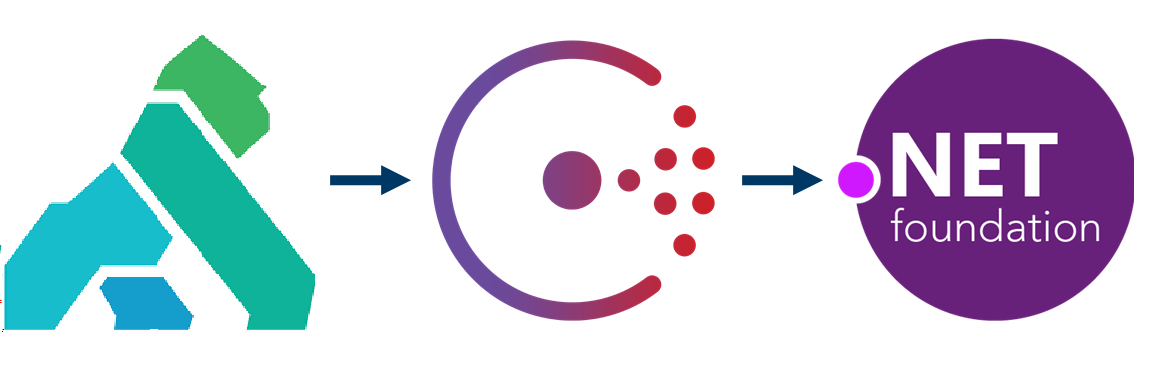
写在前面
Api网关我们之前是用 .netcore写的 Ocelot的,使用后并没有完全达到我们的预期,花了些时间了解后觉得kong可能是个更合适的选择。
简单说下kong对比ocelot打动我的:
1、kong可以直接代替Nginx/OpenRestry做前端服务器。
2、kong的功能强大,性能不俗,生态不错,操作面板,插件丰富,社区活跃;
本文目的
1、对kong和consul做个基本介绍;
2、kong集成consul 做服务发现;
3、Asp.net core WebApi 服务自动注册到Consul;
4、Asp.net core WebApi 自动注册路由规则到kong,实现程序启动即部署;
运行环境
172.16.1.30 CentOS Linux release 7.6.1810 (Core) (虚拟机单核2g)
Docker version 18.09.3, build 774a1f4
kong apigateway(enterprise) 2.3.x (docker安装)
kong
kong的简介

我们熟悉Nginx;
有个一个加强版的Nginx叫做OpenRestry,OpenRestry ≈ lua脚本+Nginx;
那么Kong 网关就是满血版的 OpenRestry,它有许许多多的的插件和各种丰富的功能,且提供对应的Rest Api,让你轻松打造你所能想象到的 网关+ web前端服务器的功能;
特点(翻译)
-
云原生:平台无关,kong支持任意平台,裸机容器或云平台;
-
k8s原生:原生支持k8s,有kong-ingress,支持l4+l7协议;
-
动态负载均衡:负载均衡到多个upstream;
-
Hash-based的负载均衡:根据cookie、session,ip等hash负载均衡;
-
断路器:自动剔除不健康的服务;
-
心跳检测:主动和被动心跳检测;
-
服务发现:通过第三方dns解析做服务发现,如consul;
-
Serverless:调用和保护 AWS Lambda or OpenWhisk functions directly ;
-
WebSockets:支持ws、wss协议;
-
gRPC:支持gRPC协议,并通过日志和插件监控流量;
-
OAuth2.0:轻松添加OAuth2.0支持;
-
日志:轻松记录请求和响应,通过HTTP, TCP, UDP, 或 直接到硬盘;
-
安全性:访问控制,爬虫检测、ip黑白名单等等;
-
Syslog:记录到系统日志;
-
SSL: 安装不同的SSL证书到服务;
-
监控:实时监控,提供关机负责负载均衡和性能指标;
-
正向代理:kong可以作为正向代理服务器;
-
身份认证:HMAC, JWT, Basic, 各种奇奇怪怪的规则都支持.
-
限制器:流量限制功能;
-
传输转换:新增、删掉、或者修改你的请求或者响应;
-
缓存:请求缓存;
-
CLI:命令行控制支持;
-
Rest Api:Rest Api控制支持;
-
Geo-Replicated:夸时区请求支持;
-
故障检测与恢复:数据库(Cassandra /postgres)节点挂掉不影响kong的服务;
-
集群:所有kong节点都自动加入集群保持配置同步;
-
拓展性:分布式拓展原生支持,水平伸缩加减节点就行;
-
高性能:使用Nginx作为核心负载均衡组件,高性能可伸缩;
-
插件:高拓展性,插件式添加功能;
详细请看
github: https://github.com/Kong/kong
官方文档: https://docs.konghq.com
kong的安装
拉取镜像
docker pull kong/kong-gateway:2.3.3.2-alpine
给镜像改个名
docker tag <IMAGE_ID> kong-ee
创建一个网络
docker network create kong-ee-net
运行一个postgresSql 9.6,用来存取kong的配置
docker run -d --name kong-ee-database \
--network=kong-ee-net \
-p 5432:5432 \
-e "POSTGRES_USER=kong" \
-e "POSTGRES_DB=kong" \
-e "POSTGRES_PASSWORD=kong" \
postgres:9.6
启动kong
docker run -d --name kong-ee2
--network=kong-ee-net \
-e "KONG_DATABASE=postgres" \
-e "KONG_PG_HOST=172.16.1.30" \
-e "KONG_PG_PASSWORD=kong" \
-e "KONG_PROXY_ACCESS_LOG=/dev/stdout" \
-e "KONG_ADMIN_ACCESS_LOG=/dev/stdout" \
-e "KONG_PROXY_ERROR_LOG=/dev/stderr" \
-e "KONG_ADMIN_ERROR_LOG=/dev/stderr" \
-e "KONG_ADMIN_LISTEN=0.0.0.0:8001" \
-e "KONG_ADMIN_GUI_URL=http://172.16.1.30:8002" \
-e "KONG_DNS_RESOLVER=172.16.1.30:8600" \ #注意按需使用,consul的才配
-p 8000:8000 \
-p 8443:8443 \
-p 8001:8001 \
-p 8444:8444 \
-p 8002:8002 \
-p 8445:8445 \
-p 8003:8003 \
-p 8004:8004 \
kong-ee
//-e "KONG_DNS_RESOLVER=172.16.1.30:8600" 注意这个配置,这是我需要用的consul的dns配置,如果不想用consul做服务发现,删掉这行
//如果既想用consul,又想用正常的域名解析服务这样配置:-e "KONG_DNS_RESOLVER=172.16.1.30:8600,114.114.114.114"
这里说明一下,kong的配置是用postgres(或者Cassandra )来存配置,但每一次请求都不需要去读取数据库的。修改的配置会直接 reload 到内存中,不影响性能;
另外说说kong的集群;
因为kong 网关其实最终 表现为一个超级前端服务器+网关,所以每个连接到同个数据库的kong实例配置一样,连接同个数据库的kong作为一个集群;
一般在kong的前面是直接做dns解析就行,如果dns不支持多ip的话做keepalive + vip就行;
验证
#admin api 获取所有服务
curl -i -X GET --url http://127.0.0.1:8001/services
#admin 管理后台
curl -i -X GET --url http://127.0.0.1:8002
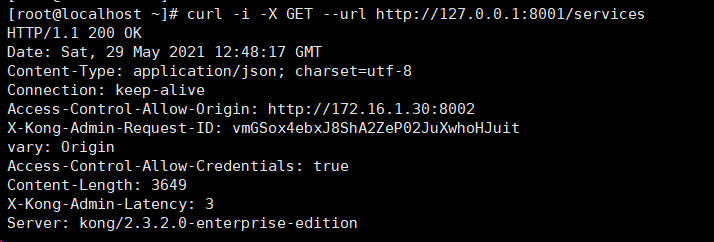

管理后台
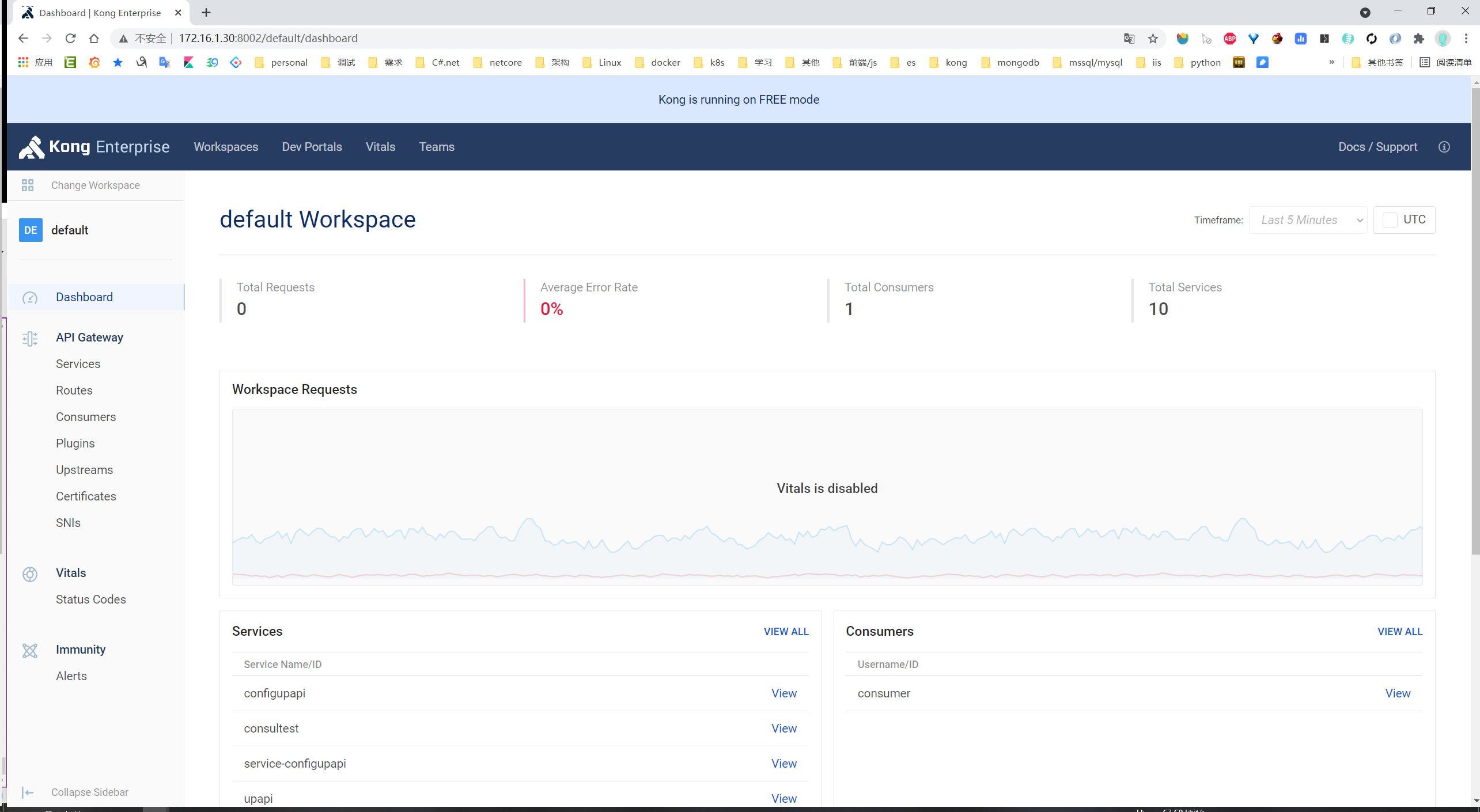
consul
consul简介

Consul是HashiCorp公司推出的开源工具,用于实现分布式系统的服务发现与配置。与其他分布式服务注册与发现的方案,比如 Airbnb的SmartStack等相比,Consul的方案更“一站式”,内置了服务注册与发现框 架、分布一致性协议实现、健康检查、Key/Value存储、多数据中心方案,不再需要依赖其他工具(比如ZooKeeper等),使用起来也较 为简单。
其实就是做服务治理的。
github: https://github.com/hashicorp/consul
官方文档: https://www.consul.io/
consul的安装
直接docker安装
*这是作为开发节点安装
docker run -d --name=dev-consul1 --network=host -e CONSUL_BIND_INTERFACE=eth0 consul:1.8
安装成功

运行一个WebApi服务
先在服务运行一个Asp.net Core WebApi (就是是新建的一个包含),我的版本是3.1的,我给服务命名:DemoApi31,监听端口5002
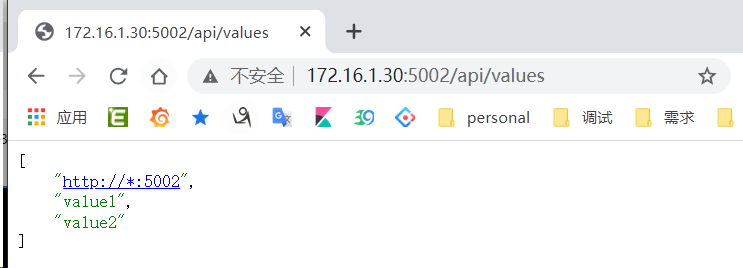
将服务注册到Consul
curl --location --request PUT 'http://172.16.1.30:8500/v1/agent/service/register' \
--header 'Content-Type: application/json' \
--data-raw '{
"ID": "DemoApi31_172.16.1.30:5002",
"Name": "DemoApi31",
"Address": "172.18.1.30",
"Port": 5002,
"EnableTagOverride": false,
"Weights": {
"Passing": 10,
"Warning": 1
}
}'
注册成功:

Dns解析验证
# 如果没安装dig 安装:yum install bind-utils
dig @172.16.1.30 -p 8600 Demoapi31.service.consul SRV
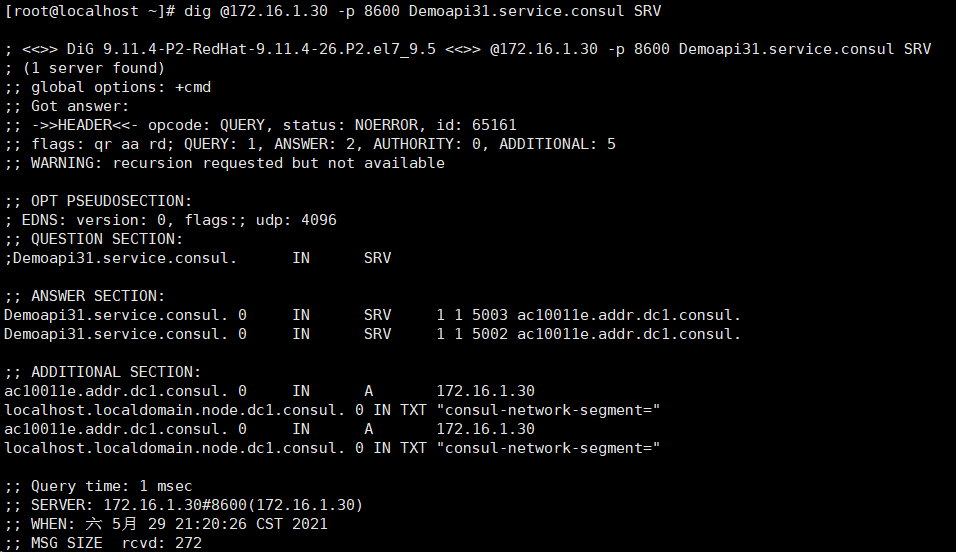
ok,我们这里已经把服务注册到consul,且能通过dns常解析到了,我们做跟kong的集成吧。
consul提供内置Dns解析和Rest Api 两种方式集成做服务发现,我们这里跟kong的集成选用的Dns方式。
kong集成consul做服务发现
因为consul的角色是dns服务器,所以非常简单,我们已注册好的 DemoApi31为例:
1、创建一个名为consul的服务
DemoApi31.service.consul 是consu要求的格式
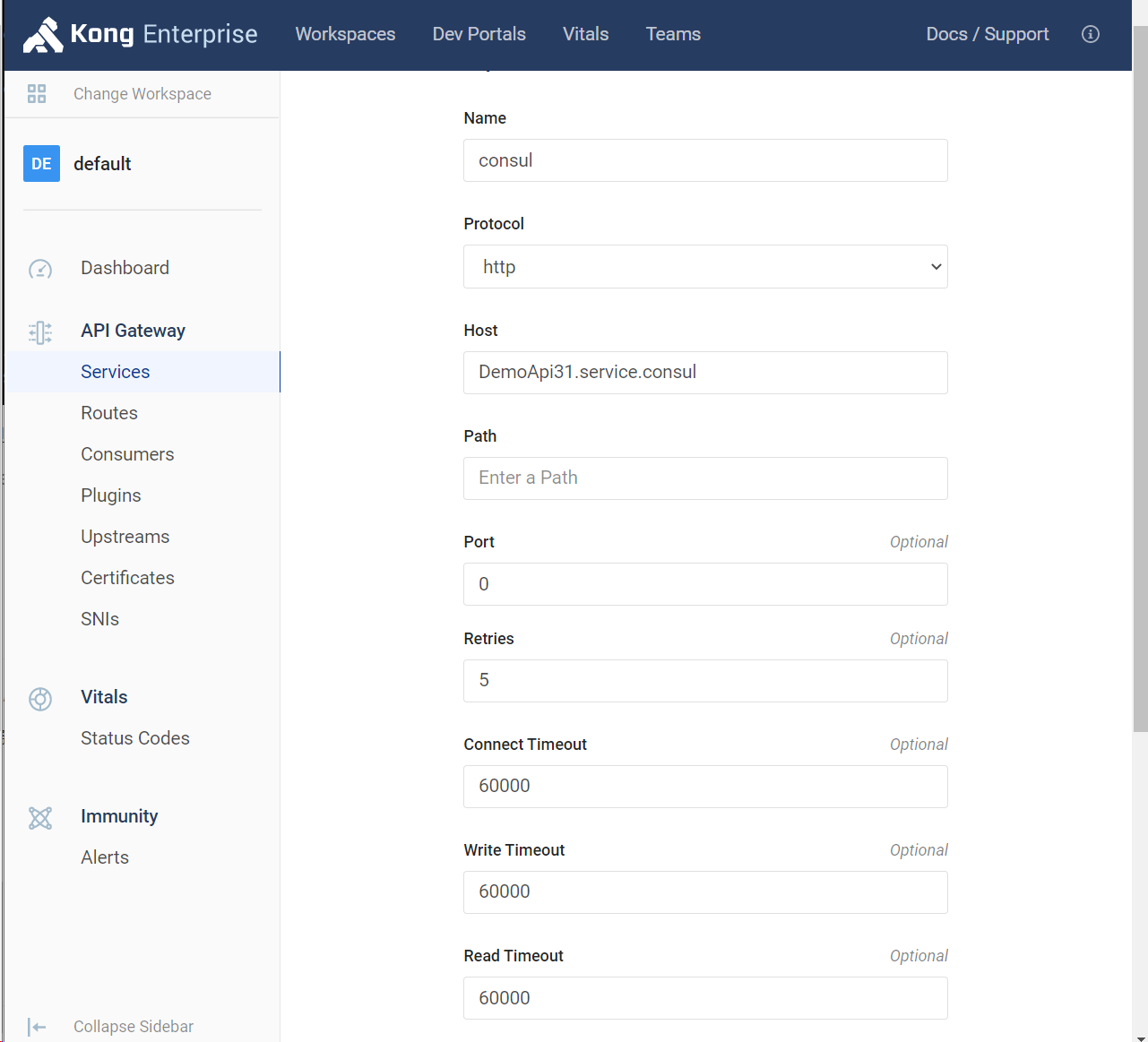
2、创建一个名为consul的路由
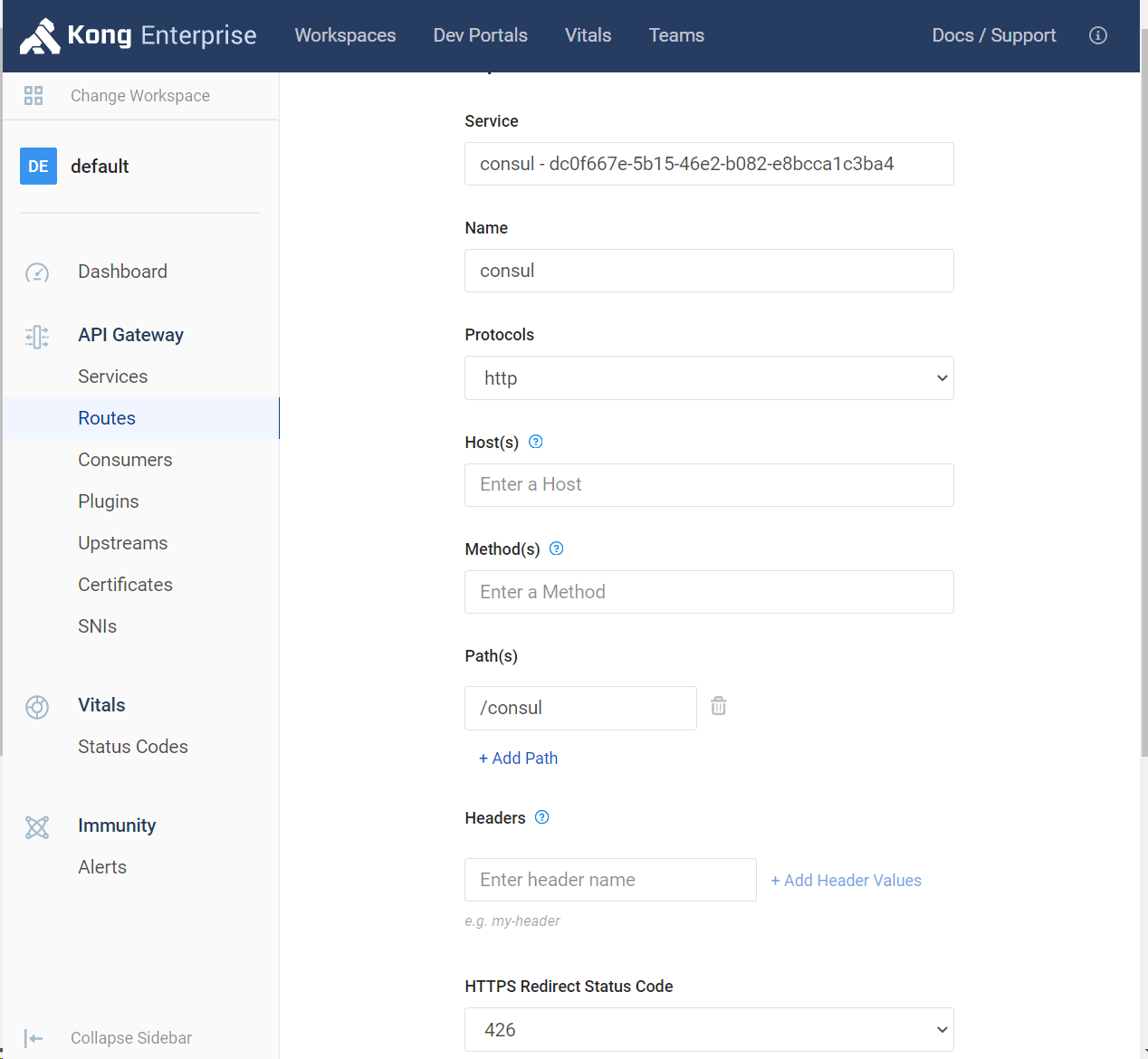
验证
访问我们配置的kong路由:http://172.16.1.30:8000/consul/api/values
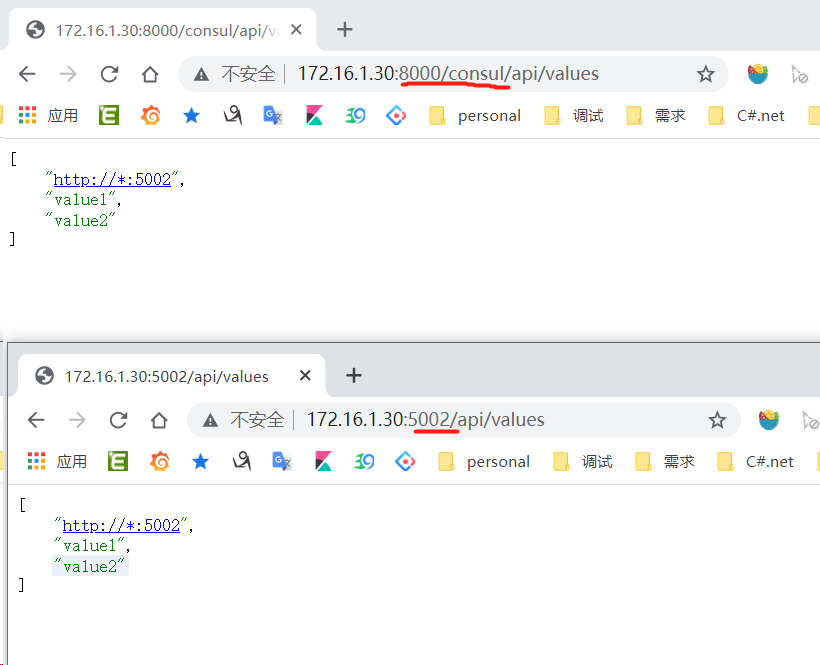
ok
到目前为止我们只完成了本文目的1、2
3,和4三请往下看;
在Asp.net Core中的使用
以之前的DemoApi31为例,换成5003端口,我需要达到的效果是,程序启动的时候就把服务注册到Consul 做好心跳检测,并同时部署到网关Kong,直接对外服务。
Asp.net Core 服务自动注册到Consul
安装nuget包
Install-Package Passport.Infrastructure -Version 0.1.4.7-preview-1
**加入配置appsettings.json**
大家主要各服务器要改成自己的
"ServiceDiscovery": {
"ServiceName": "DemoApi31",
"Consul": {
"HttpEndpoint": "http://172.16.1.30:8500",
"HttpHeathCheck": {
"Path": "/healthcheck",
"TimeOunt": 10,
"Interval": 10
},
"Tags": [
"NetCore",
"DemoApi",
"v1.0"
]
}
}
StartUp.cs ConfigureServices方法
public void ConfigureServices(IServiceCollection services)
{
//第一行
PassportConfig.InitPassportConfig(Configuration, Environment);
......
services.AddHealthChecks();
services.AddConsul();
}
StartUp.cs Configure方法
app.UseHealthChecks("/healthcheck");
启动程序
dotnet DemoApi.Core3.1.dll --healthhost 172.16.1.30 --urls http://*:5003

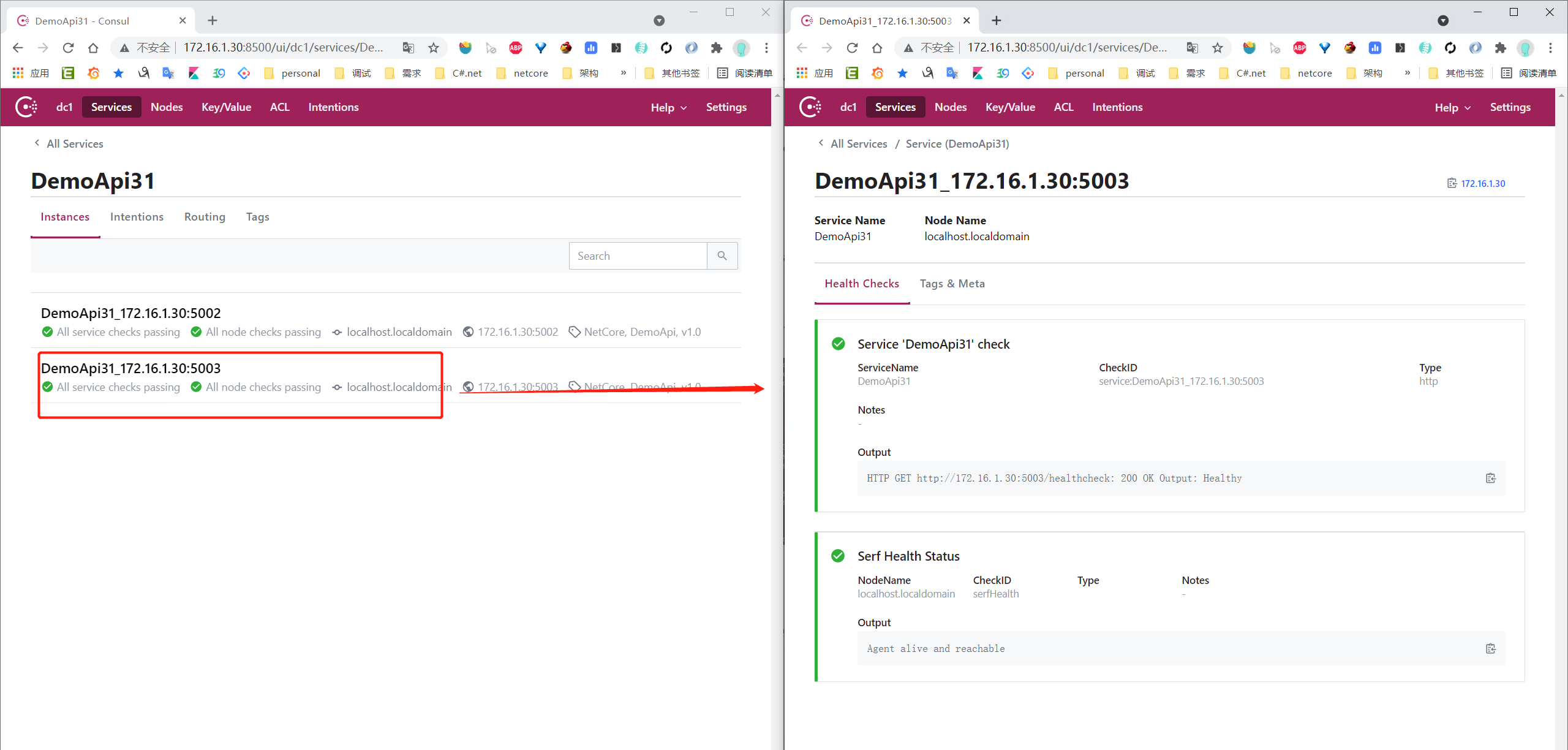
源码解析
/// <summary>
/// 加入consul做服务管理
/// </summary>
/// <param name="services"></param>
/// <returns></returns>
public static IServiceCollection AddConsul(this IServiceCollection services)
{
var options = PassportConfig.GetSection("ServiceDiscovery").Get<ServiceDiscoveryOptions>();
if (options?.Disable != true)
{
var healthHost = PassportConfig.GetHealthHost();
if (string.IsNullOrWhiteSpace(options?.ServiceName) || string.IsNullOrWhiteSpace(options?.Consul?.HttpEndPoint))
{
throw new ArgumentNullException("ServiceDiscovery.ServiceName/Consul.HttpEndpoint cannot be null or empty!");
}
//实例化kongclient
var consulClient = new ConsulClient(x => x.Address = new Uri(options.Consul.HttpEndPoint));
services.AddSingleton(consulClient);
services.Configure(new Action<ConsulOptions>(op =>
{
op.HttpEndPoint = options.Consul.HttpEndPoint;
op.Token = options.Consul.Token;
op.TcpEndPoint = options.Consul.TcpEndPoint;
}));
var checkOptions = options.Consul.HttpHeathCheck;
var checkUrl = $"http://{healthHost}:{PassportConfig.GetCurrentPort()}{checkOptions.Path}";
new ConsulBuilder(consulClient)
.AddHttpHealthCheck(checkUrl, checkOptions.TimeOunt, checkOptions.Interval)
.RegisterService(options.ServiceName, healthHost, PassportConfig.GetCurrentPort(), options.Consul.Tags)
.Wait();
}
return services;
}
ConsulBuilder.cs 参考晓晨大佬
public class ConsulBuilder
{
private readonly ConsulClient _client;
private readonly List<AgentServiceCheck> _checks = new List<AgentServiceCheck>();
public ConsulBuilder(ConsulClient client)
{
_client = client;
}
public ConsulBuilder AddHealthCheck(AgentServiceCheck check)
{
_checks.Add(check);
return this;
}
/// <summary>
///
/// </summary>
/// <param name="url"></param>
/// <param name="timeout">unit: second</param>
/// <param name="interval">check interval. unit: second</param>
/// <returns></returns>
public ConsulBuilder AddHttpHealthCheck(string url, int timeout = 10, int interval = 10)
{
_checks.Add(new AgentServiceCheck()
{
DeregisterCriticalServiceAfter = TimeSpan.FromSeconds(timeout * 3),
Interval = TimeSpan.FromSeconds(interval),
HTTP = url,
Timeout = TimeSpan.FromSeconds(timeout)
});
PassportConsole.Success($"[Consul]Add Http Healthcheck Success! CheckUrl:{url}");
return this;
}
/// <summary>
///
/// </summary>
/// <param name="endpoint">GPRC service address.</param>
/// <param name="grpcUseTls"></param>
/// <param name="timeout">unit: second</param>
/// <param name="interval">check interval. unit: second</param>
/// <returns></returns>
public ConsulBuilder AddGRPCHealthCheck(string endpoint, bool grpcUseTls = false, int timeout = 10, int interval = 10)
{
_checks.Add(new AgentServiceCheck()
{
DeregisterCriticalServiceAfter = TimeSpan.FromSeconds(20),
Interval = TimeSpan.FromSeconds(interval),
GRPC = endpoint,
GRPCUseTLS = grpcUseTls,
Timeout = TimeSpan.FromSeconds(timeout)
});
PassportConsole.Success($"[Consul]Add GRPC HealthCheck Success! Endpoint:{endpoint}");
return this;
}
public async Task RegisterService(string name, string host, int port, string[] tags)
{
var registration = new AgentServiceRegistration()
{
Checks = _checks.ToArray(),
ID = $"{name}_{host}:{port}",
Name = name,
Address = host,
Port = port,
Tags = tags
};
await _client.Agent.ServiceRegister(registration);
PassportConsole.Success($"[Consul]Register Service Success! Name:{name} ID:{registration.ID}");
AppDomain.CurrentDomain.ProcessExit += async (sender, e) =>
{
PassportConsole.Information($"[Consul] Service Deregisting .... ID:{registration.ID}");
await _client.Agent.ServiceDeregister(registration.ID);
};
}
/// <summary>
/// 移除服务
/// </summary>
/// <param name="serviceId"></param>
public async Task Deregister(string serviceId)
{
await _client?.Agent?.ServiceDeregister(serviceId);
}
}
逻辑简单,确定自己需要用的是注册服务功能,调Consul Api 注册,然后程序退出的时候注销consul的服务就行;
Asp.net core WebApi 自动注册路由规则到kong
通过Consul
安装nuget包
#已安装跳过
Install-Package Passport.Infrastructure -Version 0.1.4.7-preview-1
**加入配置appsettings.json**
guid顺便去https://www.guidgen.com/ 生成一个
"Kong": {
//"Disable": false, //true=禁用
"Host": "http://172.16.1.30:8001",
"Services": [
{
"Id": "72e21af8-283f-44c4-a766-53de8bb35c21", //guid
"Name": "service-autoapi",
"Retries": 5,
"Protocol": "http",
"Host": "DemoApi31.service.consul",
"Port": 0,
"Path": null,
"Connect_timeout": 60000, //毫秒
"Write_timeout": 60000,
"Read_timeout": 60000,
"Tags": null
}
],
"Routes": [
{
"Id": "5370e1b7-6c43-442d-9a44-23c249f958f7",
"Name": "route-autoapi",
"Protocols": [ "http" ],
"Methods": null,
"Hosts": null,
"Paths": [ "/autoapi" ],
"Https_redirect_status_code": 307,
"Regex_priority": 0,
"Strip_path": true,
"Preserve_host": false,
"Tags": null,
"Service": {
"Id": "72e21af8-283f-44c4-a766-53de8bb35c21" //这个id跟关联的Services的id一致
}
}
]
}
StartUp.cs ConfigureServices方法
public void ConfigureServices(IServiceCollection services)
{
......
services.AddConsul();
services.RouteRegistToKong();
}
启动程序
dotnet DemoApi.Core3.1.dll --healthhost 172.16.1.30 --urls http://*:5003
验证
查看kong管理后台:
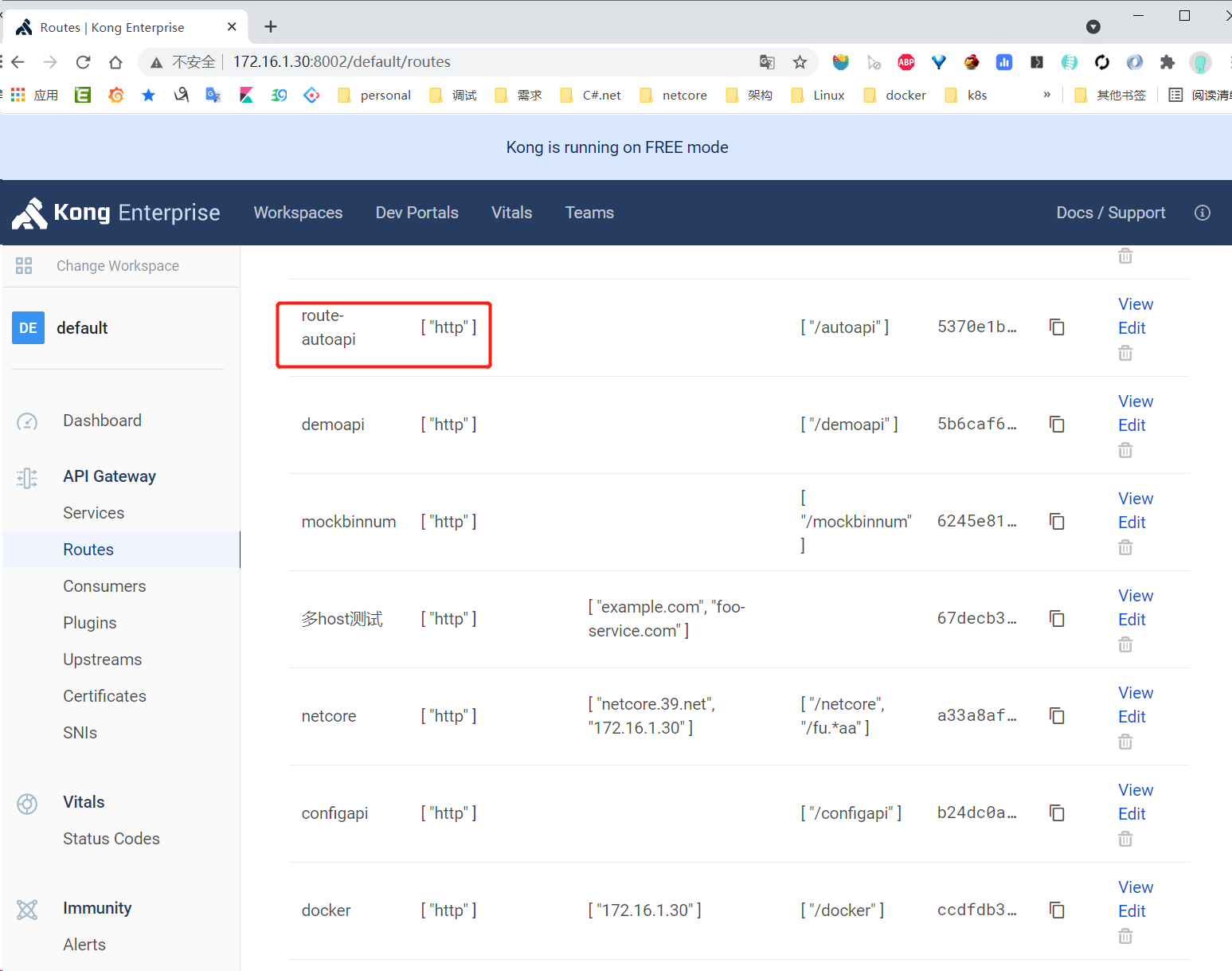
访问 http://172.16.1.30:8000/auto/api/values
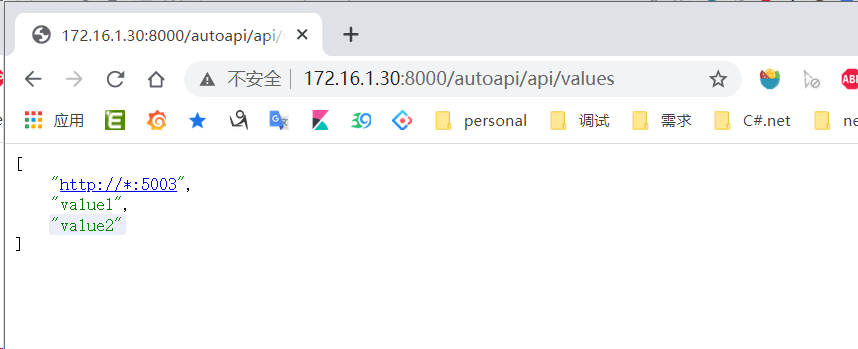
大功告成。
不通过Consul,直接配置路由到kong
StartUp.cs ConfigureServices方法
public void ConfigureServices(IServiceCollection services)
{
......
//删掉这行services.AddConsul();
services.RouteRegistToKong();
}
配置变为
"Kong": {
//"Disable": false, //true=禁用
"Host": "http://172.16.1.30:8001",
"Services": [
{
"Id": "0f86015b-b170-4ada-b045-740ae7d77ed6", //guid
"Name": "configupapi",
"Retries": 5,
"Protocol": "http",
"Host": "configupapi",
"Port": 0,
"Path": null,
"Connect_timeout": 60000, //毫秒
"Write_timeout": 60000,
"Read_timeout": 60000,
"Tags": null
}
],
"Routes": [
{
"Id": "1be79a57-af87-43b0-a0a0-b7a6cc0c5ade",
"Name": "configupapi",
"Protocols": [ "http" ],
"Methods": null,
"Hosts": null,
"Paths": [ "/configupapi" ],
"Https_redirect_status_code": 307,
"Regex_priority": 0,
"Strip_path": true,
"Preserve_host": false,
"Tags": null,
"Service": {
"Id": "0f86015b-b170-4ada-b045-740ae7d77ed6" //这个id跟Services的id一致
}
}
],
"Upstream": {
"Id": "8efd15af-df78-422f-97a0-9072fa7e7431",
"Tags": [ "exampleapi", "v1.0" ],
"Name": "configupapi",
"Hash_on": "none",
"Healthchecks": {
"Active": {
"Unhealthy": {
"Http_statuses": [ 429, 500, 501, 502, 503, 504, 505 ],
"Tcp_failures": 1,
"Timeouts": 2,
"Http_failures": 1,
"Interval": 5
},
"Type": "http",
"Http_path": "/healthcheck",
"Timeout": 1,
"Healthy": {
"Successes": 1,
"Interval": 20,
"Http_statuses": [ 200, 302 ]
},
"Https_verify_certificate": true,
"Concurrency": 1
},
"Passive": {
"Unhealthy": {
"Http_statuses": [ 429, 500, 501, 502, 503, 504, 505 ]
},
"Healthy": {
"Http_statuses": [ 200, 201, 302 ]
},
"Type": "http"
}
},
"Hash_on_cookie_path": "/",
"Hash_fallback": "none",
"Slots": 10000
},
"Target": {
"Tags": [ "exampleapi", "v1.0" ],
"Weight": 100
}
}
源码解析
/// <summary>
/// 路由注册到kong;
/// </summary>
/// <param name="services"></param>
/// <returns></returns>
public static IServiceCollection RouteRegistToKong(this IServiceCollection services)
{
if (!PassportConfig.GetBool("Kong:Disable"))
{
var konghost = PassportConfig.Get("Kong:Host") ?? throw new ArgumentNullException("Kong:Host cannot be null or empty!");
var options = new KongClientOptions(HttpClientFactory.Create(), konghost);
var client = new KongClient(options);
services.AddSingleton<KongClient>(client);
var upStream = PassportConfig.GetSection("Kong:Upstream").Get<UpStream>();
var target = PassportConfig.GetSection("Kong:Target").Get<TargetInfo>();
if (upStream != null && target != null)
{
upStream.Created_at = DateTime.Now;
upStream = client.UpStream.UpdateOrCreate(upStream).Result;
target.Target = $"{PassportConfig.GetHealthHost()}:{PassportConfig.GetCurrentPort()}";
target.Id = PassportTools.GuidFromString($"{Dns.GetHostName()}{target.Target}");
target.Created_at = DateTime.Now;
target.UpStream = new TargetInfo.UpStreamId { Id = upStream.Id.Value };
client.Target.Add(target).Wait();
PassportConsole.Success($"[Kong]UpStream registered:{upStream.Name} Target:{target.Target}");
// app.UseKongHealthChecks(upStream, onExecuter);
}
var kongServices = PassportConfig.GetSection("Kong:Services").Get<ServiceInfo[]>();
var kongRoutes = PassportConfig.GetSection("Kong:Routes").Get<RouteInfo[]>();
if (kongServices?.Length > 0 == true)
{
foreach (var item in kongServices)
{
item.Updated_at = DateTime.Now;
item.Path = string.IsNullOrWhiteSpace(item.Path) ? null : item.Path;
client.Service.UpdateOrCreate(item).Wait();
PassportConsole.Success($"[Kong]Service registered:{item.Name}");
}
}
if (kongRoutes?.Length > 0 == true)
{
foreach (var item in kongRoutes)
{
item.Updated_at = DateTime.Now;
client.Route.UpdateOrCreate(item).Wait();
PassportConsole.Success($"[Kong]Route registered:{item.Name}");
}
}
}
return services;
}
逻辑也简单,也是调用kong配置把本该手工配置的路由,分别调用upstream、service、route Api修改配置。有区别的是程序退出时不会去删对应的路由;
总结
我在各技术博客都没有看到总结的比较好的kong+consul+asp.net core的集成文章,特此总结。期待您的点赞留意;
[参考]
https://www.cnblogs.com/stulzq/p/11942691.html


 浙公网安备 33010602011771号
浙公网安备 33010602011771号